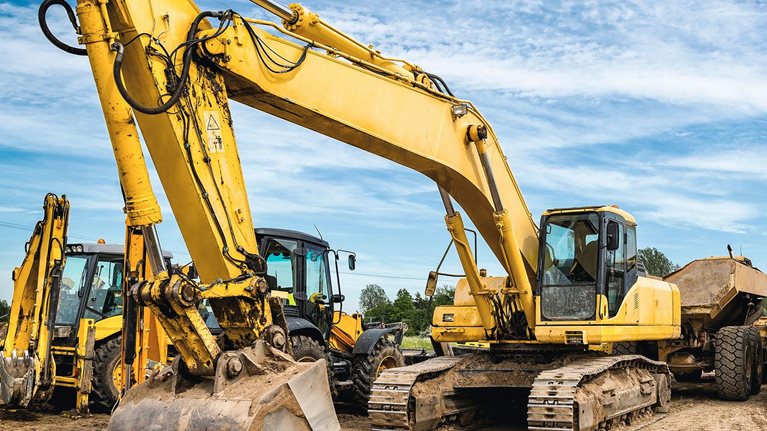As one of the world’s biggest economic ecosystems, the construction industry has a major part to play in achieving global sustainability goals. “Ecosystem” in this article refers to the full life cycle (design, materials manufacturing, construction, usage, and demolition) of all residential and commercial buildings and infrastructure. While the industry is generally not seen as a sustainability pioneer, the entire ecosystem looks set to evolve.
The COVID-19 crisis will likely prove to be a significant factor in this, not least because it will accelerate change. In this context, it is critical that we now begin to integrate the thinking and planning required to foster much greater economic and environmental resiliency to combat environmental risks.
This is a view that is reflected by industry leaders. When we asked 100 senior construction executives what trends they expected to accelerate due to the COVID-19 crisis, 53 percent cited sustainability. Reasons could include increased corporate awareness and understanding, as well as growing pressure from investors and financiers. Additionally, 10 percent said they had already increased investments in sustainability measures since the start of the crisis. Moreover, sustainability has rapidly become one of the most frequent topics that clients ask us about. An additional factor to consider is that if the lower-interest-rate environment persists and significant stimulus packages materialize, it could contribute to the deployment of new sustainable infrastructure, as well as adaptation and resilience infrastructure—investments that would support near-term job creation. Meanwhile, the need for global cooperation on this issue will likely become more apparent and more universally embraced.
Supporting our clients’ efforts to improve sustainability in construction is one of McKinsey’s core priorities. We are combining our global expertise across our Engineering, Construction & Building Materials; Sustainability; Capital Excellence; and Real Estate Practices to drive advances in this area. This article focuses on the case for change by exploring construction’s impact on greenhouse-gas (GHG) emissions in the context of buildings, examining how the industry can decarbonize, and explaining how companies in the sector can benefit.
Measuring environmental impact
Environmental, social, and governance (ESG) factors are the key measures of a business’s sustainability and societal impact within the construction ecosystem. Metrics can be assessed across the entire ecosystem and throughout the life cycle of buildings and infrastructure.1 The environmental component addresses aspects ranging from air quality and energy management to a project’s impact on biodiversity, waste, and water management. Although allocating GHG emissions across the construction ecosystem is not straightforward, we know that construction is directly or indirectly responsible for almost 40 percent of global CO₂ emissions from fuel combustion and 25 percent of GHG emissions overall (Exhibit 1).2

The construction ecosystem has a major impact on the environment through other channels as well, including the significant amount of waste generated (600.33 million US tons of construction waste in the United States alone in 2018)3, high water consumption (approximately 200 liters of water used for each cubic meter of concrete), and particulate matter (PM), or air pollution, in cities (construction is responsible for 14.5 percent of PM2.5 in big cities).4 However, in this article we focus on GHG emissions.
Global GHG emissions have risen rapidly over the past 100 years, and the planet continues to warm.5 The effects of climate change are already apparent: major flooding events, extreme heat, and agricultural degradation are on the rise, resulting in well-documented environmental consequences. From a business perspective, infrastructure, supply chains, food systems, asset prices, land and labor productivity, and economic growth itself are increasingly at risk.
The construction ecosystem is driving global emissions
GHG emissions from the construction ecosystem are mainly driven by two components: raw-material processing for buildings and infrastructure (about 30 percent of total construction emissions per year, largely cement and steel) and buildings operations (about 70 percent) (Exhibit 2). Given typical asset lifetimes of 30 to 130 years, we cannot wait to replace products at the end of their life cycle if we are to meet climate-change-mitigation targets by 2050. With roughly 80 percent of the predicted building stock for 2050 already in existence today, there is a huge need—and opportunity—to retrofit existing assets.

The contribution from raw materials comes primarily from energy-intensive cement production and through metals (about 50 percent of global steel production is used for construction), which contributes almost 7 percent of global GHG emissions. The contribution from commercial and residential building operations is mainly driven by space and water heating within buildings, heat leakage due to poor insulation, and other energy usage such as lighting, air conditioning, and appliances.
Design is the most important factor in determining GHG emissions over a building’s lifetime. By the time the construction process begins, the majority of decisions affecting the project’s GHG emissions are locked in. The ability to influence a building’s lifetime emissions is highest very early in a project and before construction has started.
Fundamental design decisions—such as new construction versus upgrading, building size and shape, level of insulation, and floor-space flexibility—can have a significant impact on emissions for decades to come.
If left unaddressed, the construction ecosystem’s carbon output is expected to grow over the next 30 years as we seek to meet the demands of an expanding population and increased urbanization. On a positive note, this opens opportunities to optimize new builds, while a simultaneous shift toward renewable energy will help to mitigate emissions. With power-system decarbonization leading to a reduction in emissions by 2050, the need to eliminate annual emissions remains significant for the construction and real estate ecosystem to meet the 2016 Paris Agreement’s 1.5-degree warming target.6
Nevertheless, tackling emissions will be challenging. Providing incentives for players across the value chain to take joint action is a necessary part of this process. The construction ecosystem is in the midst of a transition that is reshaping all parts of the industry. A further challenge is how to deploy smart technologies across millions of locations in an industry with the second-lowest level of digitalization and relatively low levels of productivity growth.7
Focusing on specific decarbonization initiatives can be cost-effective
The scale of the problem is substantial, as are the challenges faced by the player in the ecosystem. But the good news is that there are clear actions each player can take to dramatically reduce its carbon footprint—and many of these actions will also deliver cost savings. However, a combined effort will be required across both existing and new building stock if the industry is to achieve its ultimate goal of net-zero emissions at an ecosystem level. To chart the decarbonization pathway of the construction industry, we have assessed a range of levers to decarbonization. Each lever is assessed for abatement potential, and for cost, on a net-present-value (NPV) basis, to assess the abatement cost in euros per ton of CO₂. For the European markets alone, we have modeled more than 1,000 business cases to establish the most cost-effective pathway to decarbonization.
This assessment shows that it is possible to reach net-zero emissions for operating buildings at an average cost of €5 per ton of CO₂, contributing substantially to the overall net-zero pathway that can be achieved at net-zero cost by 2050 in Europe.
Would you like to learn more about our Engineering, Construction & Building Materials Practice?
Average abatement costs for other sectors vary significantly: for example, the industry abatement cost averages €85 per ton abated, transport €–120 per ton abated and agriculture €–25 per ton abated. Given that the average building emits two tons of CO₂ per year, the average annual cost increase would be only €10 per dwelling per building per year—an increase to the average energy bill of approximately 1 percent. Moreover, even without the more expensive abatement levers, the heating would still experience 85 percent abatement.
Taking a closer look at emissions from the operation of existing buildings, we see that within the European Union, 70 percent of energy consumption relates to heating. Two factors are important: the energy efficiency of the building (thermal insulation and heating-control systems) and the energy source used for heating (for example, using renewable electricity to drive heat pumps versus gas boilers). There are many cost-effective approaches to emissions abatement, with insulation and a move to solar thermal the most cost-effective (Exhibit 3). Switching to renewable technologies in heating accounts for 72 percent of emissions reductions, supporting the pathway to net-zero both for the building sector and for the European Union more broadly.

One NPV-positive move would be to upgrade insulation of dwellings. Transitioning from low insulation (an Energy Performance Certificate [EPC] rating of F and G) to medium (an EPC rating of C, D, and E) is generally cost positive. This is primarily because insulation—which includes walls, roof, floor, and glazing with materials such as fiberglass, mineral wool, polystyrene, and glass—has a long life span. Over the course of 50 years, upgraded insulation can reduce energy demand by about 30 percent. In Europe, the majority of existing buildings are not well insulated: out of 245 million dwellings, around 135 million have a low level of insulation, and 85 million of these are heated with fossil fuels. The European Union estimates that 97 percent of buildings built before 2010 need renovation to comply with long-term strategic ambitions. Our calculations indicate that, to achieve these ambitions by 2050, current renovation rates need to more than double—up from today’s approximately 1.0 percent to about 2.5 percent.8 This highlights the fact that, while such action is NPV positive, it nevertheless involves huge complexity and remains a major undertaking.
Significantly, the energy-demand reductions from increased levels of insulation contribute only around 20 percent of overall emissions reductions; the largest reductions are achieved by switching to renewable technologies for heating. Importantly, however, these technologies are enabled by improved insulation levels as they only operate efficiently in well-insulated buildings. The most significant shifts in heating systems include moving 40 percent of residential and commercial buildings to heat pumps by 2050 (versus 2 percent now), 33 percent to district heating (versus 12 percent now), 15 percent to biogas or hydrogen boilers (versus 0 percent now) and 10 percent to solar thermal as an add-on technology (versus 2 percent now).
Reducing the emissions impact of new builds
Turning to new building construction, we see that it is responsible for more than 2.5 gigatons of CO₂e globally (5 percent of total GHG emissions). Concrete and steel processing represents the largest share (60 percent) of embodied carbon because of the large quantities of each material incorporated in a typical structure and the energy-intensive production process.
Reducing emissions for new builds requires a different approach than that for decarbonizing building operations. Regulations for new builds are currently tightening, requiring higher levels of insulation: for example, new buildings in the European Union are now subject to the Energy Performance of Buildings Directive. In addition, decarbonization of materials can be achieved through a combination of several main measures:
- Demand reduction and circularity. Lowering demand for primary resources through design and process optimization (including reduced waste, improved building footprints, and limited overspecifications), and by increasing closed-loop circularity for materials and components (including increased usage of scrap material and reduced recycling-yield losses). Using generative design to create outcome-based designs that help frame and clarify how different materials and design choices can lower GHG emissions
- Optimizing construction and material. Shifting commonly used materials and equipment to alternatives that are more energy efficient, including substitution by low-carbon materials, higher-performing materials, and electrification of heavy equipment. Pushing toward productization of projects, modularization, and off-site construction to reduce the overall footprint of the construction process
- Material decarbonization. Reducing emissions during production of required materials, including increased production efficiencies, electrification of processing equipment, and technology advancements
We have modeled a potential abatement pathway for materials and construction processes, taking as an example a European residential building (five stories, 500-square-meter footprint), to assess the optimal combination of the principal measures (Exhibit 4). This model was based on input from our global pool of sector experts and the latest scientific literature.

The pathway for this vision of net-zero carbon buildings at zero cost increase may require a rethinking of basic principles and a combination of existing and alternative materials. The optimal mix of these will vary for different buildings and locations. Analysis for the building used in this illustration (mainly based around well-known and more-established levers) suggests that most abatement potential comes from reducing upstream emissions in the material-production process (optimizing construction and materials, 40 percent). The remainder of the abatement potential comes from lowering demand, including primary resources and circularity. The pathway suggests that a share of these measures would bring cost savings to the industry.
Companies stand to benefit from tackling emissions
Capital markets are shifting toward ESG, with more and cheaper capital available for sustainable players. We expect this to be one driver of a rapid increase in demand for ESG-friendly buildings. Furthermore, consumers are becoming as aware of the emissions generated by their homes and workplaces as they are of the environmental impact of what they drive, how they travel, and what they eat.
We believe that the decarbonization and sustainability focus will shift inexorably toward construction and real estate, following scrutiny of other industries in recent years. At the same time, the drive toward sustainability brings significant opportunities for value creation. Encouragingly, the construction and real estate sector recognizes this: according to a recent survey of 400 global industry leaders, the vast majority (80 percent) consider sustainability to be the driver most likely to lead to a transformational industry shift over the next one to five years. We also see leading companies committing seriously to decarbonization; one global player has committed to a 50 percent reduction in GHG emissions by 2030 and to ensuring a carbon-neutral project portfolio by 2045.
Companies can benefit from approaching ESG as a strategic opportunity versus the traditional view that it is simply a cost that is hard to pass on to other players in the value chain (for example, tenants or developers). As discussed, many carbon-abatement levers can be cost-effective. Within operations ESG could involve installing insulation and district heating in Europe or, in the context of construction of new stock, reducing demand for primary resources through design and process optimization and shifting from commonly used materials to more energy-efficient ones. To capitalize on the strategic opportunities, players should consider changes in value pools, respond to megatrends such as new technology and services with new business models, and boldly tap into the capital market.

The next normal in construction: How disruption is reshaping the world’s largest ecosystem
By contrast, a failure to act now could leave construction open to serious challenges from future entrants operating closer to market expectations, through increasingly stringent regulation that incentivizes low-carbon players and penalizes others, or because capital markets limit investments in companies that lack a serious commitment to decarbonization. New players entering the market can focus on the main trends disrupting an industry without having to undergo a transformational shift. This can translate into a significant advantage over more-established players.
The smart-buildings segment is expected to grow at 10 to 13 percent CAGR until 2025; examples range from new materials and approaches to tackling waste sources to green-design solutions based on building-information modeling and IoT-based energy management.9 Equally, recent years have seen a significant increase in societal pressure on companies to reduce their environmental impact, and growing regulatory pressure puts businesses across the construction and real estate ecosystem at risk; building-material suppliers, for example, have the highest exposure among all industries to higher carbon prices in terms of earnings before interest, taxes, depreciation, and amortization (EBITDA).10 Regulators in more than 50 countries have already established or are planning a form of carbon taxation.
No single player in the ecosystem can tackle the emissions issue alone
The construction ecosystem is highly fragmented, with many steps along the product life cycle. Although each player in this highly complex ecosystem can make a difference and capture opportunities, collaborative efforts among various stakeholders are likely to yield the best results. We have explored the role several key players can contribute to this transformation; for example, developers can influence design and planning, while contractors can have an impact on construction of new buildings and upgrades to existing stock. Depending on the asset type, each stakeholder has an impact on emissions at multiple stages of the product life cycle; equally, large chunks of emissions are affected by multiple players (Exhibit 5).

Moreover, the impacts of the emissions transition will be unevenly distributed, creating challenges for many individual companies and actors. Stakeholders must prepare for significant changes to policies and regulations, risk-sharing schemes (such as performance-based, energy-reduction contracts), alternative-financing models (for example, green mortgages), and digital innovations (for instance, blockchain-based platforms designed to allocate savings from energy-efficiency investments).
As demand and regulatory pressures mount, the construction ecosystem needs to identify mechanisms to address these pressures. For example, engineering companies will need to optimize cost and ESG design based on lifetime cost (as opposed to upfront cost), and contractors will have to minimize waste, ensure recycling, and replace diesel-powered equipment.
The construction industry is experiencing multiple disruptions, but the drive to sustainability is racing ahead. Just ten years ago, zero-emissions vehicles were only a concept; now they are a reality. Change is arriving quickly, and we are already seeing many modifications to new and existing projects. Accelerating this journey and addressing the challenge head-on will be key.


